Ap world final questions Practice test 1
1/54
There's no tags or description
Looks like no tags are added yet.
Name | Mastery | Learn | Test | Matching | Spaced |
|---|
No study sessions yet.
55 Terms
The commercial practices shown in the images emerged in order to
A
facilitate the development of regional trade networks by creating uniform currencies and systems of credit.
B
finance imperial conquests by supplying credit and currency for purchasing weapons.
C
facilitate a growing trade in luxury goods by providing greater access to credit and currency.
D
finance transnational Chinese artisan businesses across Eurasia by diversifying sources of credit and currency.
C
facilitate a growing trade in luxury goods by providing greater access to credit and currency.
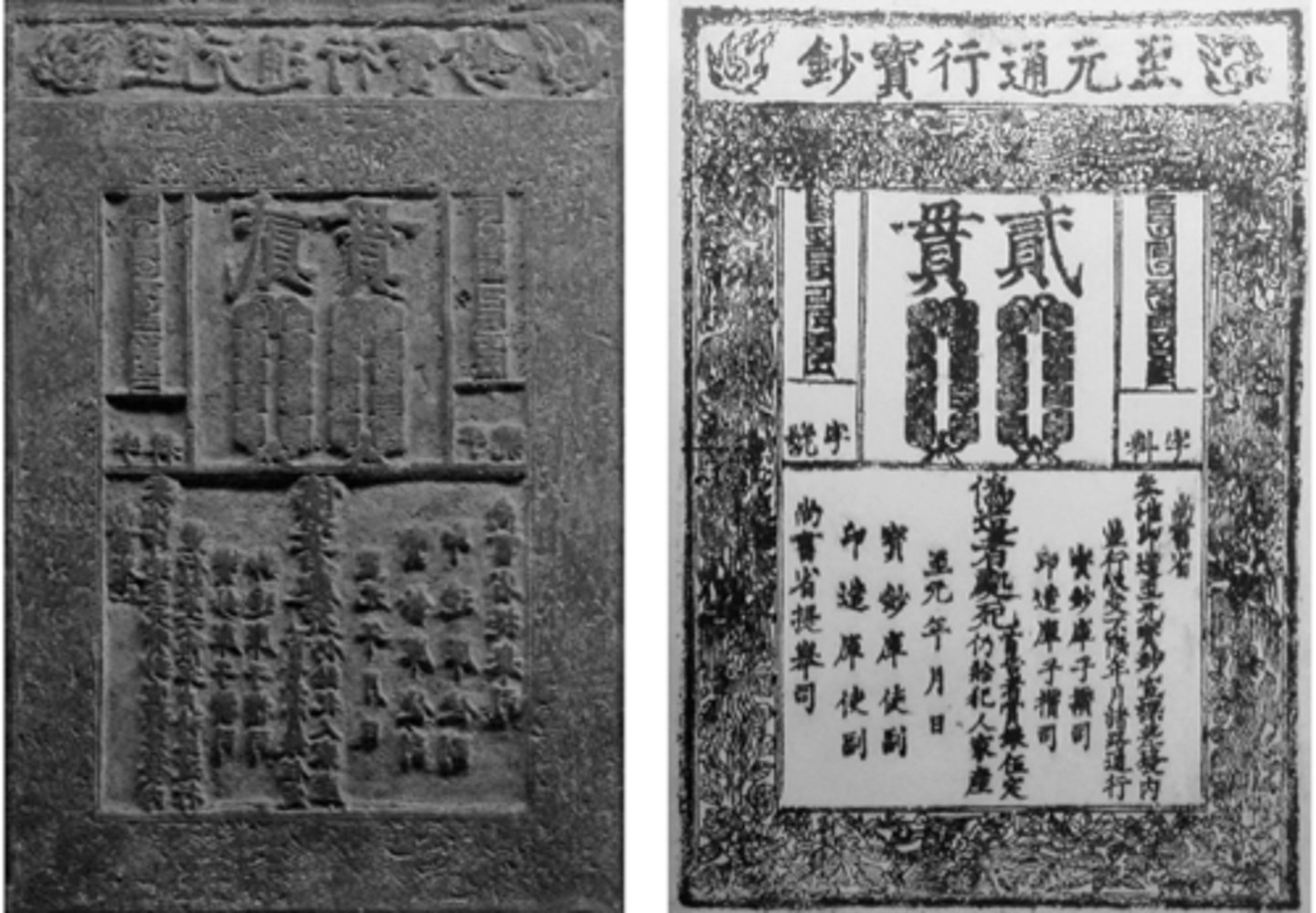
Image 1 could best be used as evidence of the ways in which
A
the introduction of new commercial practices fostered urban expansion.
B
new commercial technologies helped expand literacy.
C
imperial states attempted to expand commercial activity.
D
commerce fostered cultural unity in some politically fragmented regions.
C
imperial states attempted to expand commercial activity.
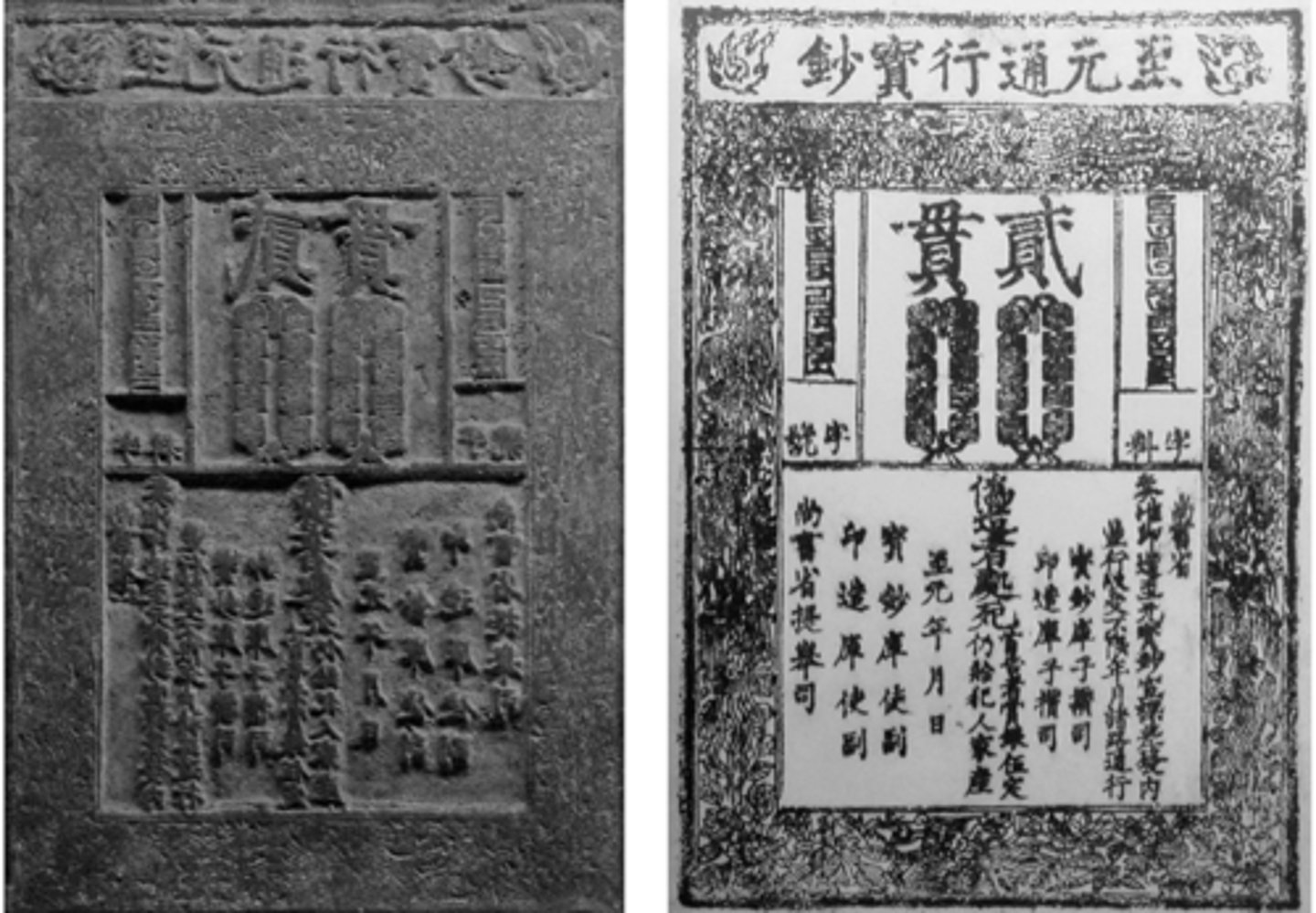
The author’s portrayal of the activities shown in Image 2 was most directly informed by
A
aristocratic resentment of peasants
B
Christian religious ideals
C
royal concern about the growing wealth of merchants
D
aristocratic ideals of chivalry and valor
B
Christian religious ideals

All of the following statements about the use of the currency shown in Image 1 in China under the Yuan dynasty are factually accurate. Which best explains why the currency often led to hyperinflation?
A
The Yuan government forced private citizens to surrender their gold and silver and accept paper currency in its place.
B
Excessive amounts of currency were printed in order to fund military expeditions and reward local elites.
C
The Mongol Ilkhanate in Persia also briefly modeled its monetary policy on the paper currency printed in Yuan China.
D
Travelers to Yuan China noted that only paper currency was accepted for business transactions.
B
Excessive amounts of currency were printed in order to fund military expeditions and reward local elites.
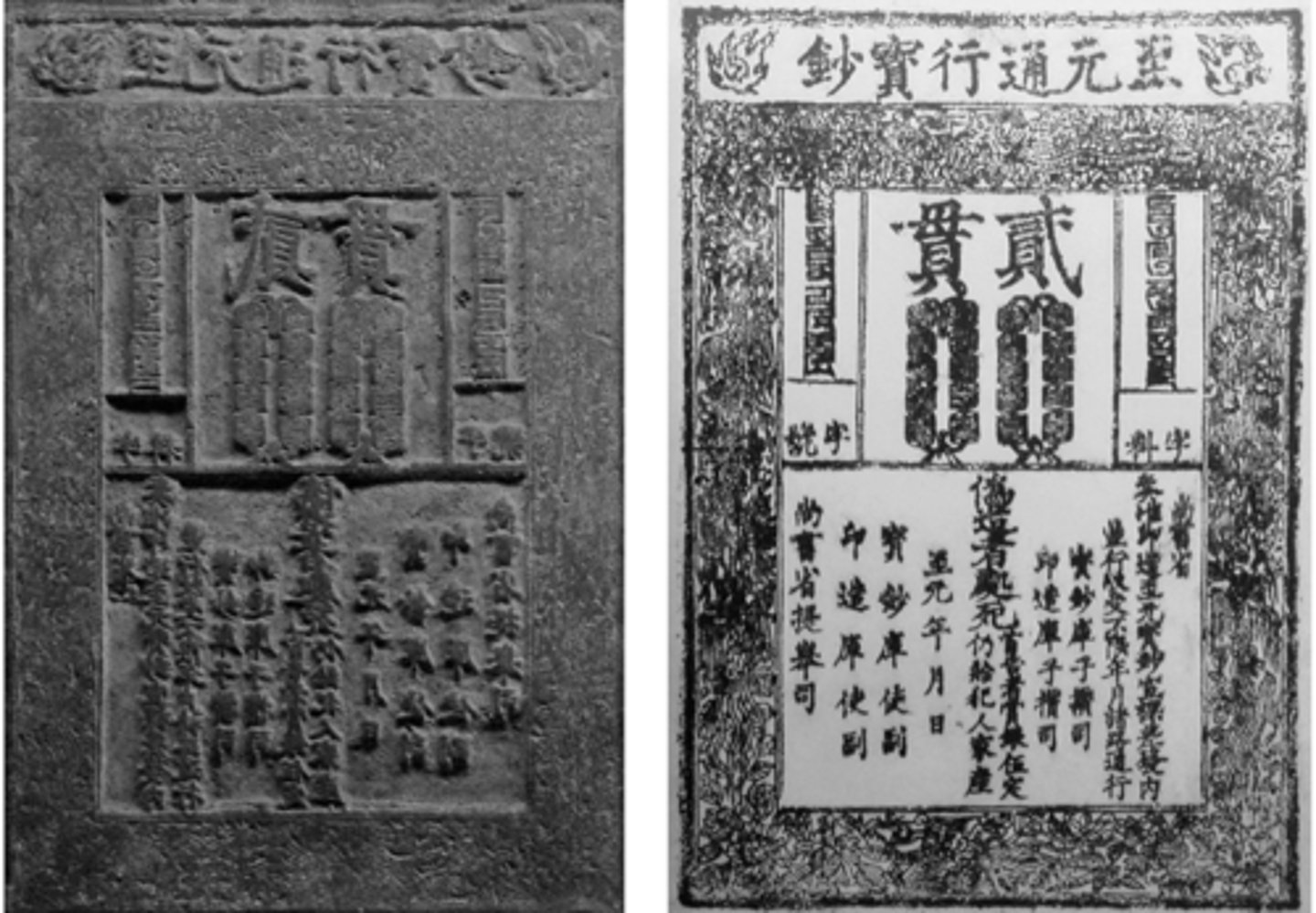
Source 1
“People who follow Judaism should pass their lives among Christians quietly, practicing their own religion and not speaking ill of Christianity. Moreover, a Jewish person should not attempt to convert any Christian. Whoever violates this law shall be put to death and lose his property.
Jewish people may maintain their synagogues, but they cannot build new synagogues without our permission. Christians may not deface synagogues or steal anything from them. Jewish people shall not be forced to attend court by Christian officials on Saturdays [the Jewish Sabbath]. All legal claims between Christians and the Jewish community shall be decided by our royal judges and a Christian is forbidden from arresting or harming Jewish people or seizing their property.
Christians may not use force to convert a Jewish person to Christianity, though Christians should use the Holy Scriptures and kind words. Jewish people, however, should not attempt to interfere with a member of their community converting to Christianity of their own will. Any Christian, however, who converts to Judaism shall be put to death as a heretic.”
Law code issued by Alfonso X, king of the Christian Spanish kingdom of Castile, circa 1265
Source 2
“King Ferdinand and Queen Isabella, by the grace of God, King and Queen of Spain, greetings.
We learned that some wicked Christians in our kingdom adopted Jewish religious practices and cultural customs and apostatized from our holy Catholic faith because these Christians interacted with Jewish people. Therefore, we, with the counsel and advice of the clergy, noblemen, and other persons of learning and wisdom in our kingdom, order the Jewish community to depart and never to return. And we forbid any person or persons in our kingdom to receive, protect, or defend any Jewish person under pain of losing all their possessions, vassals, fortified places, and whatever financial grants they hold from us.”
The two passages best illustrate which of the following continuities in world history?
A
While some states sought to impose religious uniformity on their populations, others embraced religious syncretism.
B
While some states used religion to legitimize their power, others used military or bureaucratic means.
C
While some states were willing to tolerate diversity within their territories, others suppressed diversity.
D
While some states allowed for numerous official religions, others recognized only one official religion.
C
While some states were willing to tolerate diversity within their territories, others suppressed diversity.
Source 1
“People who follow Judaism should pass their lives among Christians quietly, practicing their own religion and not speaking ill of Christianity. Moreover, a Jewish person should not attempt to convert any Christian. Whoever violates this law shall be put to death and lose his property.
Jewish people may maintain their synagogues, but they cannot build new synagogues without our permission. Christians may not deface synagogues or steal anything from them. Jewish people shall not be forced to attend court by Christian officials on Saturdays [the Jewish Sabbath]. All legal claims between Christians and the Jewish community shall be decided by our royal judges and a Christian is forbidden from arresting or harming Jewish people or seizing their property.
Christians may not use force to convert a Jewish person to Christianity, though Christians should use the Holy Scriptures and kind words. Jewish people, however, should not attempt to interfere with a member of their community converting to Christianity of their own will. Any Christian, however, who converts to Judaism shall be put to death as a heretic.”
Law code issued by Alfonso X, king of the Christian Spanish kingdom of Castile, circa 1265
Source 2
“King Ferdinand and Queen Isabella, by the grace of God, King and Queen of Spain, greetings.
We learned that some wicked Christians in our kingdom adopted Jewish religious practices and cultural customs and apostatized from our holy Catholic faith because these Christians interacted with Jewish people. Therefore, we, with the counsel and advice of the clergy, noblemen, and other persons of learning and wisdom in our kingdom, order the Jewish community to depart and never to return. And we forbid any person or persons in our kingdom to receive, protect, or defend any Jewish person under pain of losing all their possessions, vassals, fortified places, and whatever financial grants they hold from us.”
The policy toward minority religious groups described in Source 1 is most consistent with the policy toward minority religious groups in Islamic states in the period before 1450 because it
A
required certain minority religious groups to pay a poll tax
B
was often not strictly enforced by local officials
C
granted limited personal freedom and protection
D
allowed minority religious groups to use their traditional legal systems
C
granted limited personal freedom and protection
Source 1
“People who follow Judaism should pass their lives among Christians quietly, practicing their own religion and not speaking ill of Christianity. Moreover, a Jewish person should not attempt to convert any Christian. Whoever violates this law shall be put to death and lose his property.
Jewish people may maintain their synagogues, but they cannot build new synagogues without our permission. Christians may not deface synagogues or steal anything from them. Jewish people shall not be forced to attend court by Christian officials on Saturdays [the Jewish Sabbath]. All legal claims between Christians and the Jewish community shall be decided by our royal judges and a Christian is forbidden from arresting or harming Jewish people or seizing their property.
Christians may not use force to convert a Jewish person to Christianity, though Christians should use the Holy Scriptures and kind words. Jewish people, however, should not attempt to interfere with a member of their community converting to Christianity of their own will. Any Christian, however, who converts to Judaism shall be put to death as a heretic.”
Law code issued by Alfonso X, king of the Christian Spanish kingdom of Castile, circa 1265
Source 2
“King Ferdinand and Queen Isabella, by the grace of God, King and Queen of Spain, greetings.
We learned that some wicked Christians in our kingdom adopted Jewish religious practices and cultural customs and apostatized from our holy Catholic faith because these Christians interacted with Jewish people. Therefore, we, with the counsel and advice of the clergy, noblemen, and other persons of learning and wisdom in our kingdom, order the Jewish community to depart and never to return. And we forbid any person or persons in our kingdom to receive, protect, or defend any Jewish person under pain of losing all their possessions, vassals, fortified places, and whatever financial grants they hold from us.”
The attitude toward religious practice expressed in Source 2 was most directly apparent in which of the following Spanish policies in the Americas in the period circa 1500–1750 ?
A
The establishment of the casta system
B
The state sponsorship of Jesuit missions to native populations
C
The use of the encomienda system
D
The development of Candomblé and Voudun among African slave populations
B
The state sponsorship of Jesuit missions to native populations
Source 1
“People who follow Judaism should pass their lives among Christians quietly, practicing their own religion and not speaking ill of Christianity. Moreover, a Jewish person should not attempt to convert any Christian. Whoever violates this law shall be put to death and lose his property.
Jewish people may maintain their synagogues, but they cannot build new synagogues without our permission. Christians may not deface synagogues or steal anything from them. Jewish people shall not be forced to attend court by Christian officials on Saturdays [the Jewish Sabbath]. All legal claims between Christians and the Jewish community shall be decided by our royal judges and a Christian is forbidden from arresting or harming Jewish people or seizing their property.
Christians may not use force to convert a Jewish person to Christianity, though Christians should use the Holy Scriptures and kind words. Jewish people, however, should not attempt to interfere with a member of their community converting to Christianity of their own will. Any Christian, however, who converts to Judaism shall be put to death as a heretic.”
Law code issued by Alfonso X, king of the Christian Spanish kingdom of Castile, circa 1265
Source 2
“King Ferdinand and Queen Isabella, by the grace of God, King and Queen of Spain, greetings.
We learned that some wicked Christians in our kingdom adopted Jewish religious practices and cultural customs and apostatized from our holy Catholic faith because these Christians interacted with Jewish people. Therefore, we, with the counsel and advice of the clergy, noblemen, and other persons of learning and wisdom in our kingdom, order the Jewish community to depart and never to return. And we forbid any person or persons in our kingdom to receive, protect, or defend any Jewish person under pain of losing all their possessions, vassals, fortified places, and whatever financial grants they hold from us.”
Royal decree issued by King Ferdinand II and Queen Isabella of Spain, 1492
Which of the following states in the period 1450–1750 adopted a religious policy that was most different from the religious policy expressed in Source 2 ?
A
The Mughal Empire under Akbar
B
The Safavid Empire under Shah Ismail I
C
The Ottoman Empire
D
The Tokugawa Shogunate
A
The Mughal Empire under Akbar
The burial depicted in the image most likely resulted from the spread of which of the following?
A
Spanish influenza
B
Malaria
C
Smallpox
D
Bubonic plague
D
Bubonic plague
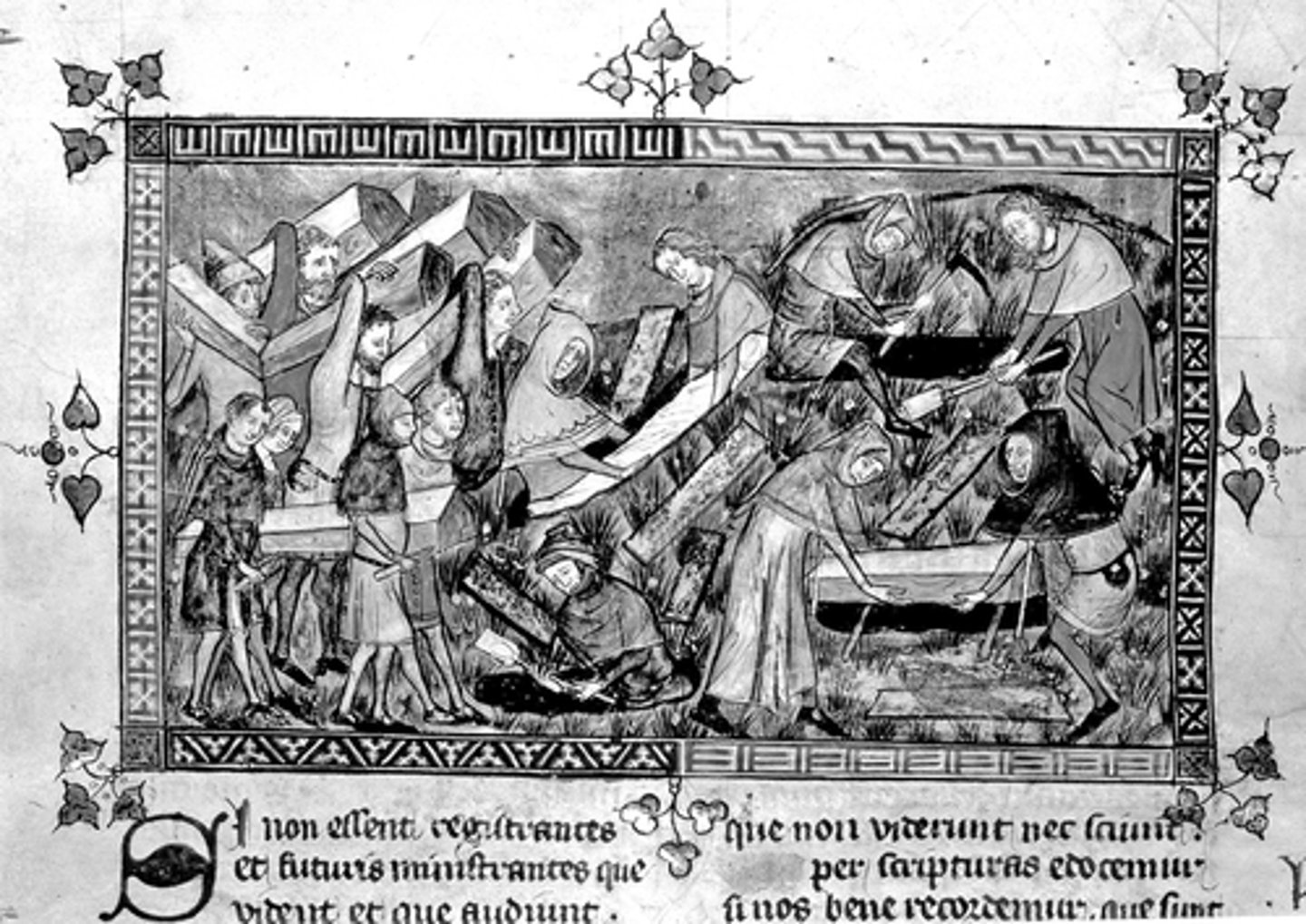
Which of the following best explains why, in the mid fourteenth century, events of the type depicted in the image were more common in urban areas of Afro-Eurasia than in rural or mountainous regions?
A
The disease principally spread along trade routes, and most commerce occurred in urban areas.
B
People in rural and mountainous regions had greater access to natural medicines that could fight the disease.
C
People in rural and mountainous regions were better able to flee to the safety of their lords’ castles.
D
The disease principally spread among religious missionaries, and most missionaries traveled to cities.
A
The disease principally spread along trade routes, and most commerce occurred in urban areas.

The mortality depicted in the image most directly contributed to which of the following changes in Europe in the late fourteenth and fifteenth centuries?
A
The end of feudalism
B
The decline of serfdom
C
The collapse of the Byzantine Empire
D
B
The decline of serfdom

“[D]espite his ferocity, his military genius and his shrewd adaptation of tribal politics to his imperial purpose, Tamerlane’s* system fell apart at his death. As he himself may have grasped intuitively, it was no longer possible to. . . build a Eurasian empire on [nomadic] foundations. . . . The Ottomans, the Mamluk state in Egypt and Syria, the Muslim sultanate in northern India, and above all China were too resilient to be swept away by his lightning campaigns.
Indeed Tamerlane’s death marked in several ways the end of a long phase in global history. His empire was the last real attempt to challenge the partition of Eurasia between the states of the Far West, Islamic Middle Eurasia and Confucian East Asia. Secondly, his political experiments and ultimate failure revealed that power had begun to shift back decisively from the nomad empires to the settled states. . . . Lastly, his passing coincided with the first signs of a change in the existing pattern of long-distance trade, the [overland Silk Road route] that he had fought to control. Within a few decades after his death, the idea of a world empire ruled from Samarkand [Tamerlane’s Central Asian capital] had become [a fantasy].”
*a Turko-Mongolic ruler who conquered much of Central Asia and the Middle East in the late 1300s and early 1400s.
John Darwin, British historian, After Tamerlane: The Rise and Fall of Global Empires, 1400–2000, published in 2008
Which of the following developments in the late fifteenth century could best be used as evidence to support Darwin’s argument in the second paragraph regarding a change in patterns of long-distance trade?
A
The growing naval power of the Ottoman Empire in the Mediterranean
B
The discovery of maritime routes that linked Europe and Asia through the Indian Ocean
C
The naval expeditions of the Ming admiral Zheng He
D
The development of the Atlantic system that linked Europe to the Americas and Africa
B
The discovery of maritime routes that linked Europe and Asia through the Indian Ocean
“[D]espite his ferocity, his military genius and his shrewd adaptation of tribal politics to his imperial purpose, Tamerlane’s* system fell apart at his death. As he himself may have grasped intuitively, it was no longer possible to. . . build a Eurasian empire on [nomadic] foundations. . . . The Ottomans, the Mamluk state in Egypt and Syria, the Muslim sultanate in northern India, and above all China were too resilient to be swept away by his lightning campaigns.
Indeed Tamerlane’s death marked in several ways the end of a long phase in global history. His empire was the last real attempt to challenge the partition of Eurasia between the states of the Far West, Islamic Middle Eurasia and Confucian East Asia. Secondly, his political experiments and ultimate failure revealed that power had begun to shift back decisively from the nomad empires to the settled states. . . . Lastly, his passing coincided with the first signs of a change in the existing pattern of long-distance trade, the [overland Silk Road route] that he had fought to control. Within a few decades after his death, the idea of a world empire ruled from Samarkand [Tamerlane’s Central Asian capital] had become [a fantasy].”
*a Turko-Mongolic ruler who conquered much of Central Asia and the Middle East in the late 1300s and early 1400s.
John Darwin, British historian, After Tamerlane: The Rise and Fall of Global Empires, 1400–2000, published in 2008
Which of the following most strongly contributed to the shift of power from nomadic empires to settled states that Darwin identifies in the second paragraph?
A
The development and spread of gunpowder weapons across Eurasia
B
The development of new shipbuilding and navigational techniques
C
The spread of epidemic diseases across Eurasia, such as the Black Death
D
The increased recruitment of nomadic soldiers by large agricultural states
A
The development and spread of gunpowder weapons across Eurasia
“[D]espite his ferocity, his military genius and his shrewd adaptation of tribal politics to his imperial purpose, Tamerlane’s* system fell apart at his death. As he himself may have grasped intuitively, it was no longer possible to. . . build a Eurasian empire on [nomadic] foundations. . . . The Ottomans, the Mamluk state in Egypt and Syria, the Muslim sultanate in northern India, and above all China were too resilient to be swept away by his lightning campaigns.
Indeed Tamerlane’s death marked in several ways the end of a long phase in global history. His empire was the last real attempt to challenge the partition of Eurasia between the states of the Far West, Islamic Middle Eurasia and Confucian East Asia. Secondly, his political experiments and ultimate failure revealed that power had begun to shift back decisively from the nomad empires to the settled states. . . . Lastly, his passing coincided with the first signs of a change in the existing pattern of long-distance trade, the [overland Silk Road route] that he had fought to control. Within a few decades after his death, the idea of a world empire ruled from Samarkand [Tamerlane’s Central Asian capital] had become [a fantasy].”
*a Turko-Mongolic ruler who conquered much of Central Asia and the Middle East in the late 1300s and early 1400s.
John Darwin, British historian, After Tamerlane: The Rise and Fall of Global Empires, 1400–2000, published in 2008
Which of the following developments in the period 1450–1750 could best be used as evidence to modify Darwin’s argument in the first paragraph about the establishment of Eurasian empires on “nomadic foundations”?
A
The creation of the Ottoman Empire
B
The Ming overthrow of the Yuan dynasty in China
C
The fall of the Mughal Empire
D
The establishment of the Safavid Empire
D
The establishment of the Safavid Empire
“[D]espite his ferocity, his military genius and his shrewd adaptation of tribal politics to his imperial purpose, Tamerlane’s* system fell apart at his death. As he himself may have grasped intuitively, it was no longer possible to. . . build a Eurasian empire on [nomadic] foundations. . . . The Ottomans, the Mamluk state in Egypt and Syria, the Muslim sultanate in northern India, and above all China were too resilient to be swept away by his lightning campaigns.
Indeed Tamerlane’s death marked in several ways the end of a long phase in global history. His empire was the last real attempt to challenge the partition of Eurasia between the states of the Far West, Islamic Middle Eurasia and Confucian East Asia. Secondly, his political experiments and ultimate failure revealed that power had begun to shift back decisively from the nomad empires to the settled states. . . . Lastly, his passing coincided with the first signs of a change in the existing pattern of long-distance trade, the [overland Silk Road route] that he had fought to control. Within a few decades after his death, the idea of a world empire ruled from Samarkand [Tamerlane’s Central Asian capital] had become [a fantasy].”
*a Turko-Mongolic ruler who conquered much of Central Asia and the Middle East in the late 1300s and early 1400s.
John Darwin, British historian, After Tamerlane: The Rise and Fall of Global Empires, 1400–2000, published in 2008
All of the following statements about nomadic empires in the period 1200–1700 are factually accurate. Which statement most likely explains why Tamerlane’s empire rapidly declined in the late fifteenth century?
A
Nomadic empires contained numerous ethnic and religious groups within their territories.
B
Nomadic empires frequently sought to control key trade routes in order to secure access to luxury goods.
C
Nomadic empires often used the governmental systems of sedentary societies to rule agricultural regions.
D
Nomadic empires typically contained numerous tribes and confederations that were difficult to control.
D
Nomadic empires typically contained numerous tribes and confederations that were difficult to control.
Based on the location of the painting, it can be inferred that its primary purpose was to
A
inspire religious devotion among the Golkonda rulers' ordinary subjects
B
serve as a model for Indian court painters in training
C
bolster the legitimacy of the Golkonda dynasty by celebrating its past
D
impress foreign dignitaries and other visitors with the might of the Golkonda military forces
C
bolster the legitimacy of the Golkonda dynasty by celebrating its past

The particular event depicted in the painting was likely important to Golkonda rulers mostly because it
A
could be used as a symbol of the union between the state’s ruling class and the majority of its population
B
provided a source of pride for Golkonda’s Muslim population by reminding them of the Muslim conquests of India
C
led to the decline of patriarchal social structures in the Indian subcontinent
D
illustrated the extent to which Golkonda elites relied on various forms of coerced labor
A
could be used as a symbol of the union between the state’s ruling class and the majority of its population
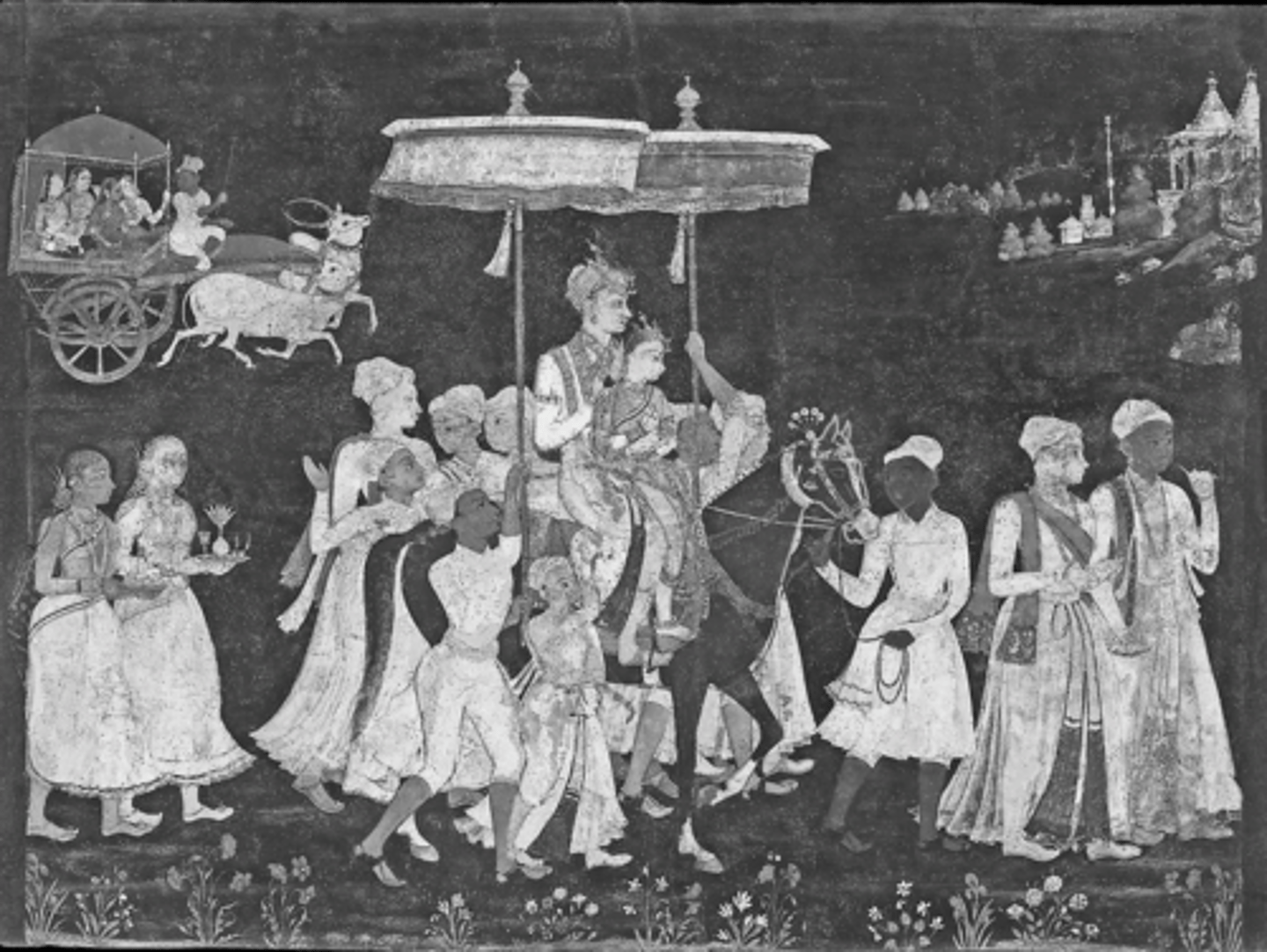
Which of the following most likely describes the fate of the Golkonda state after 1650 ?
A
It expanded to control most of India.
B
It was conquered by the Portuguese.
C
It was conquered by the Mughal Empire.
D
It was conquered by the Ottoman Empire.
C
It was conquered by the Mughal Empire.

In the context of the period 1450–1750, which of the following most likely explains why the Qing government employed the scholars shown in the image?
A
States sought to recruit foreign experts to industrialize their economies.
B
States sought to legitimize their rule by recruiting foreigners from prestigious universities.
C
States sought to centralize their rule by including foreigners whose positions were dependent on the state to serve in the bureaucracy.
D
States sought to recruit foreigners who could help factions within the state bureaucracies solve their differences.
C
States sought to centralize their rule by including foreigners whose positions were dependent on the state to serve in the bureaucracy.
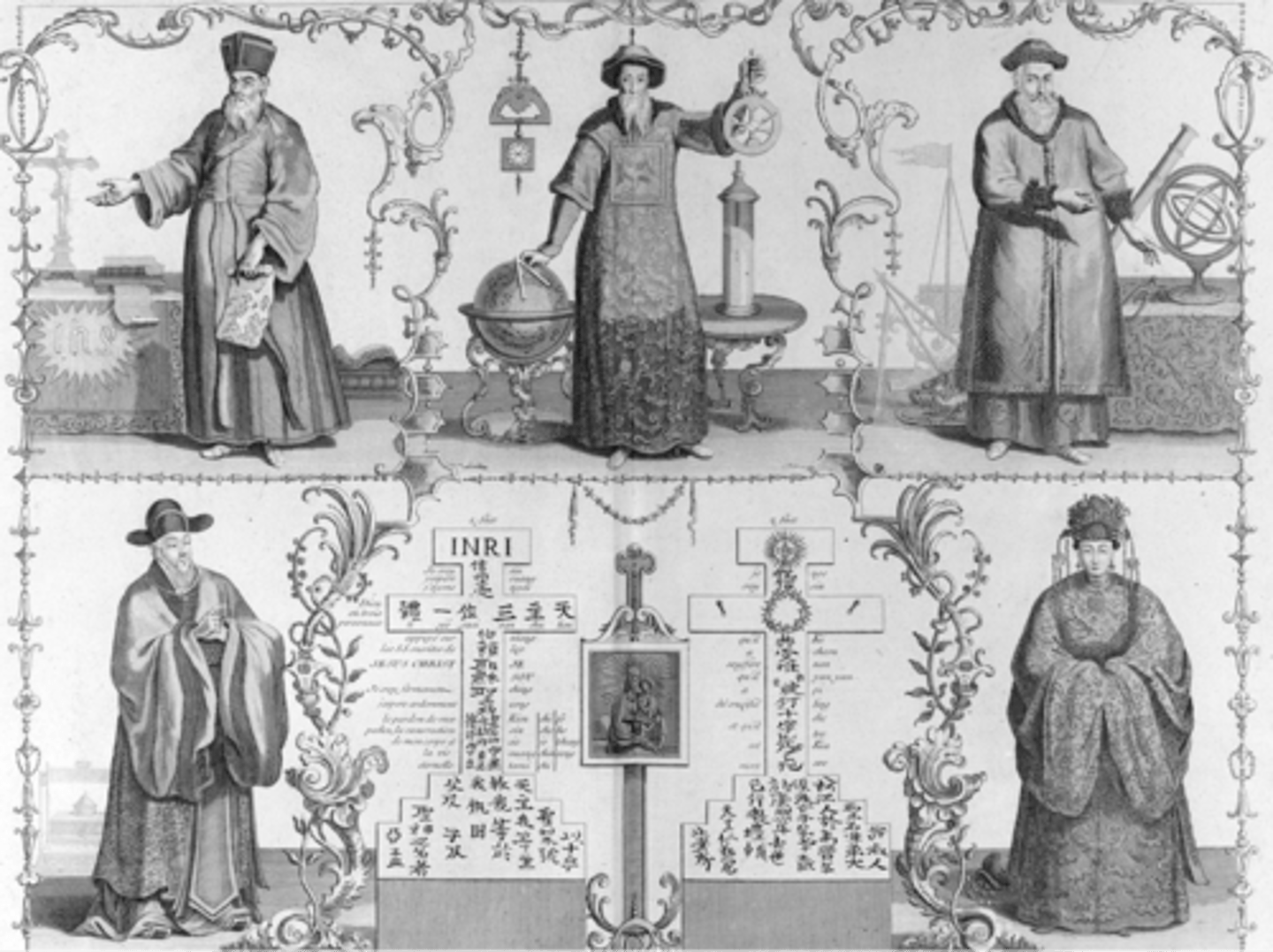
Which of the following developments in Europe in the sixteenth and seventeenth centuries most directly helps to explain the presence of the scholars shown in the image of China?
A
The Inquisition led to the expulsion of enemies of the Catholic Church from Europe.
B
The Protestant Reformation led the Catholic Church to seek new converts outside of Europe.
C
The wars of religion led many to question the role of religion in European society.
D
The expansion of the Ottoman Empire in Europe led many to leave their homes as refugees.
B
The Protestant Reformation led the Catholic Church to seek new converts outside of Europe.
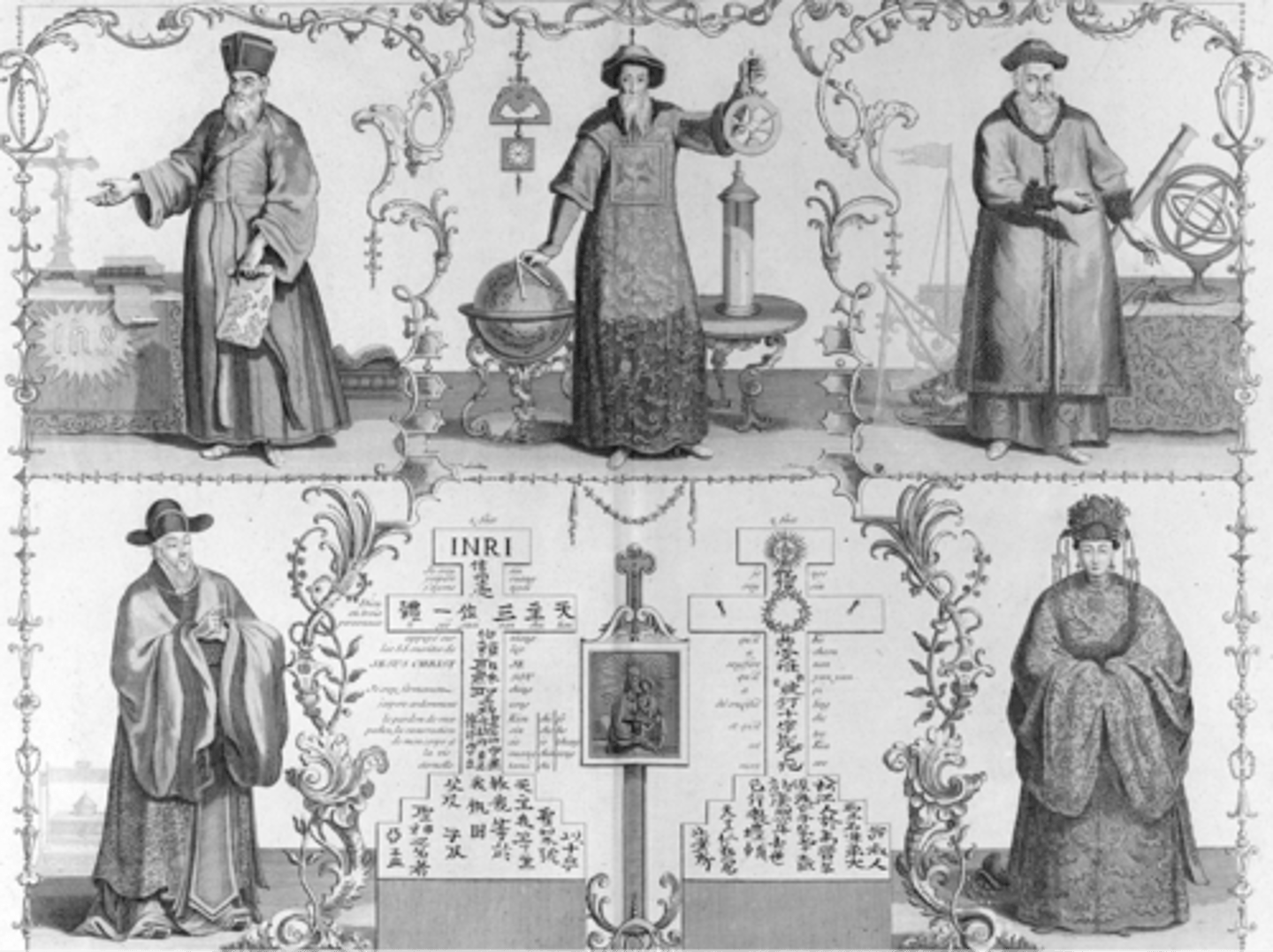
The spread of new cultural ideas, such as those illustrated by the religious beliefs of Xu Guangxi and Candida Xu, most strongly encouraged some Asian governments in Eurasia in the period 1450–1750 to
A
expand educational opportunities for the lower classes
B
limit trade and other contacts with foreigners
C
advocate for the peaceful settlement of existing religious conflicts
D
develop national joint-stock companies
B
limit trade and other contacts with foreigners
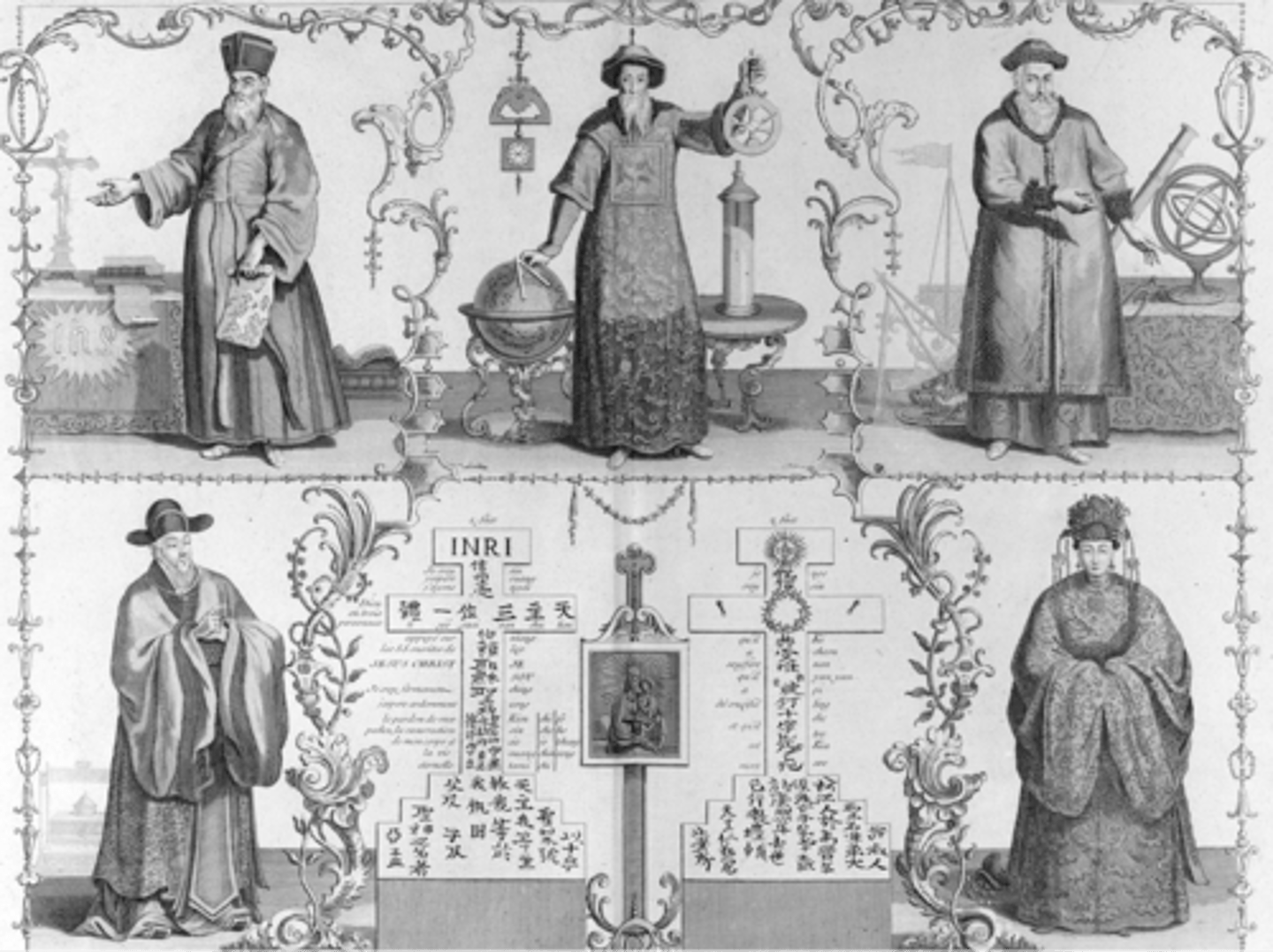
All of the following statements about Du Halde are factually accurate. Which would most likely lead historians to question the objectivity of his portrayal of the scholars shown in the image?
A
He was the confessor to an important French noble.
B
He never traveled to China.
C
He based his observations of China on unpublished translations of Chinese texts.
D
He was a Jesuit and based his book on Jesuit missionary reports.
D
He was a Jesuit and based his book on Jesuit missionary reports.
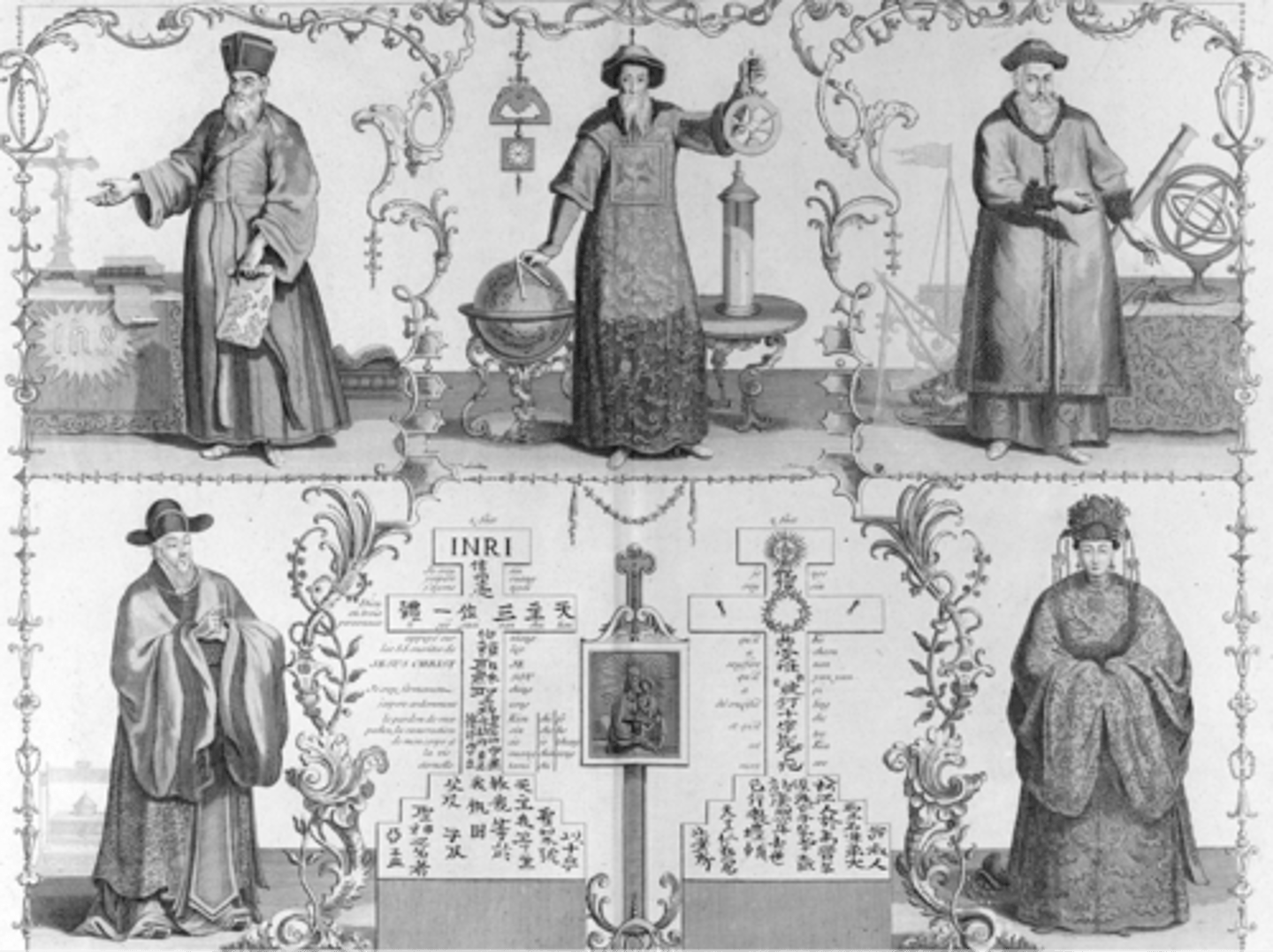
To advocate for violent rebellion against British colonial authorities
B
To demonstrate the racial oppression suffered by free people of color in the West Indies
C
To argue for the respectability of free people of color
D
To call for greater emigration by Europeans to the West Indies
C
To argue for the respectability of free people of color

The artist’s perspective on the subject of the painting was most likely influenced by which of the following?
A
The Enlightenment
B
Nationalism
C
Social Darwinism
D
The Haitian Revolution
A
The Enlightenment

Which of the following best explains why the painting was seen as a challenge to social conventions when it was painted?
A
Women were rarely the subject of paintings in European art of the period.
B
Caribbean society was built on racial hierarchies that generally reserved elite status for people of European ancestry.
C
In most cultures of the period, children were not considered worthy of being portrayed in art until they reached adulthood.
D
Caribbean society was predominantly matriarchal, with men expected to play strictly domestic roles in the household.
B
Caribbean society was built on racial hierarchies that generally reserved elite status for people of European ancestry.

Which of the following most directly led to the arrival of substantial numbers of Africans in the Americas at the time of the painting?
A
The collapse of the Inca and Aztec Empires as a result of Spanish invasion
B
The growth of industrial production in the United States
C
The expansion of the plantation system for growing sugarcane and other crops
D
The development of large-scale silver mining operations in South America
C
The expansion of the plantation system for growing sugarcane and other crops

Which of the following likely contributed the most to the population changes shown in the table for Latin American states such as Argentina and Brazil in the period 1800–1900 ?
A
Increased economic production resulting from slave labor
B
Large increases in immigration from Europe
C
Higher birth rates resulting from the development of antibiotics
D
More equitable land distribution policies following independence from Spain
B
Large increases in immigration from Europe

Which of the following most likely accounts for the extent of the population changes for Argentina, Brazil, and Saudi Arabia in the period 1950–2000 ?
A
The introduction of agricultural techniques associated with the Green Revolution
B
Religious restrictions on the use of birth control
C
The implementation of socialist economic policies
D
The introduction of desalination technologies from Western states
A
The introduction of agricultural techniques associated with the Green Revolution

The population trend shown in the table for sub-Saharan African states such as Angola and Zimbabwe in the period 1950–2000 most likely reflects which of the following?
A
Increased political stability
B
Increased wealth from the sale of natural resources
C
The greater availability of vaccines
D
The greater availability of financial assistance from international institutions
C
The greater availability of vaccines

During the second half of the twentieth century, population trends in which of the following regions most strongly contrasted with the overall trends illustrated in the table?
A
Southeast Asia
B
North Africa
C
South Asia
D
North America
D
North America

“The Jiaqing emperor asked the governor Sun Yuting: ’Is Britain wealthy and powerful?’
Sun Yuting responded, ‘Britain is larger than other European countries and is, therefore, powerful. But its power comes from its wealth, which is derived from China. This country is allowed to trade at the port of Canton. It exchanges its goods for our tea. It then resells the tea to Europe and to its colonies in the West, thus becoming wealthy and powerful. Yet, tea is as important to the West as rhubarb is to Russia. If we put an embargo on tea exports, Britain will fall into poverty and its people into sickness. How powerful, then, could Britain possibly be compared to China?’”
Sun Yuting, governor of the southern Chinese province of Guangdong, autobiographical account of his conversation with the Jiaqing emperor of the Qing dynasty, early nineteenth century
Sun Yuting’s analysis of the factors that contributed to the relative economic strength of China and Great Britain best illustrates which of the following continuities from the period 1450–1750 ?
A
The expansion of empires led to the collapse of existing trade networks.
B
The transfer of European navigational technology expanded global trade significantly.
C
The global circulation of goods was fueled by European merchants’ access to Asian markets.
D
The establishment of state monopolies in certain industries led to higher prices for luxury items.
D
The establishment of state monopolies in certain industries led to higher prices for luxury items.
“The Jiaqing emperor asked the governor Sun Yuting: ’Is Britain wealthy and powerful?’
Sun Yuting responded, ‘Britain is larger than other European countries and is, therefore, powerful. But its power comes from its wealth, which is derived from China. This country is allowed to trade at the port of Canton. It exchanges its goods for our tea. It then resells the tea to Europe and to its colonies in the West, thus becoming wealthy and powerful. Yet, tea is as important to the West as rhubarb is to Russia. If we put an embargo on tea exports, Britain will fall into poverty and its people into sickness. How powerful, then, could Britain possibly be compared to China?’”
Sun Yuting, governor of the southern Chinese province of Guangdong, autobiographical account of his conversation with the Jiaqing emperor of the Qing dynasty, early nineteenth century
The emperor’s question to Sun Yuting was most likely intended to assess which of the following?
A
The degree to which religious conflicts in Europe had weakened Great Britain militarily
B
The relative risks of continuing to pursue a trade policy that forced foreign states to acknowledge China’s political superiority
C
The possibility for the establishment of Chinese colonies in Asia and the Americas
D
The potential advantages of making an alliance with Great Britain to prevent further Japanese expansion in East Asia
B
The relative risks of continuing to pursue a trade policy that forced foreign states to acknowledge China’s political superiority
“The Jiaqing emperor asked the governor Sun Yuting: ’Is Britain wealthy and powerful?’
Sun Yuting responded, ‘Britain is larger than other European countries and is, therefore, powerful. But its power comes from its wealth, which is derived from China. This country is allowed to trade at the port of Canton. It exchanges its goods for our tea. It then resells the tea to Europe and to its colonies in the West, thus becoming wealthy and powerful. Yet, tea is as important to the West as rhubarb is to Russia. If we put an embargo on tea exports, Britain will fall into poverty and its people into sickness. How powerful, then, could Britain possibly be compared to China?’”
Sun Yuting, governor of the southern Chinese province of Guangdong, autobiographical account of his conversation with the Jiaqing emperor of the Qing dynasty, early nineteenth century
Sun Yuting’s analysis of the potential effect of a trade embargo on Great Britain could best be characterized as
A
inaccurate, because Sun Yuting failed to account for the fact that Great Britain’s economy had largely industrialized
B
inaccurate, because Sun Yuting failed to recognize how new methods of agriculture had greatly increased the quality of food available to Great Britain’s urban poor
C
accurate, because Sun Yuting recognized how much the possession of colonies burdened Great Britain’s economy
D
accurate, because Sun Yuting understood that revolutionary wars had bankrupted Great Britain
B
inaccurate, because Sun Yuting failed to recognize how new methods of agriculture had greatly increased the quality of food available to Great Britain’s urban poor
“The Jiaqing emperor asked the governor Sun Yuting: ’Is Britain wealthy and powerful?’
Sun Yuting responded, ‘Britain is larger than other European countries and is, therefore, powerful. But its power comes from its wealth, which is derived from China. This country is allowed to trade at the port of Canton. It exchanges its goods for our tea. It then resells the tea to Europe and to its colonies in the West, thus becoming wealthy and powerful. Yet, tea is as important to the West as rhubarb is to Russia. If we put an embargo on tea exports, Britain will fall into poverty and its people into sickness. How powerful, then, could Britain possibly be compared to China?’”
Sun Yuting, governor of the southern Chinese province of Guangdong, autobiographical account of his conversation with the Jiaqing emperor of the Qing dynasty, early nineteenth century
Which of the following best characterizes the economic situation of most Asian states such as China at the end of the nineteenth century?
A
They had become dependent on imports of natural resources from Western states.
B
Although their agricultural exports declined, their share of global manufacturing increased.
C
They became dependent on the maritime commerce of their joint-stock companies.
D
Although their overall wealth declined, they continued to produce finished goods.
D
Although their overall wealth declined, they continued to produce finished goods.
“The essence of education, our traditional national aim, is to promote benevolence, justice, loyalty, filial piety, and knowledge and skill. But recently, people have been going to extremes by embracing a foreign civilization whose only values are fact-gathering and technical-skill. These values bring harm to our customary ways. We try to incorporate the best features of foreigners in order to achieve the lofty goals that the Meiji emperor desires. We have tried to abandon the undesirable practices of the past and learn from the outside world. But these policies have had a serious defect. They have reduced benevolence, justice, loyalty, and filial piety to secondary goals. If we indiscriminately imitate foreign ways, our people will forget the great principles governing the relations between ruler and subject and the relations between father and son.”
Motoday Nagazane, adviser to the Meiji emperor, treatise written following a tour of Japanese schools with the emperor, 1879
The ideals of traditional Japanese education that the author praises in the passage are most closely aligned with the social ideals advocated by which of the following?
A
Buddhism
B
Christianity
C
Confucianism
D
Daoism
C
Confucianism
“The essence of education, our traditional national aim, is to promote benevolence, justice, loyalty, filial piety, and knowledge and skill. But recently, people have been going to extremes by embracing a foreign civilization whose only values are fact-gathering and technical-skill. These values bring harm to our customary ways. We try to incorporate the best features of foreigners in order to achieve the lofty goals that the Meiji emperor desires. We have tried to abandon the undesirable practices of the past and learn from the outside world. But these policies have had a serious defect. They have reduced benevolence, justice, loyalty, and filial piety to secondary goals. If we indiscriminately imitate foreign ways, our people will forget the great principles governing the relations between ruler and subject and the relations between father and son.”
Motoday Nagazane, adviser to the Meiji emperor, treatise written following a tour of Japanese schools with the emperor, 1879
The Meiji government’s “emulation of foreign ways” was most directly a response to which of the following nineteenth-century developments?
A
The Qing Empire forcing Japan to accept tributary relations
B
Western states forcing Japan to open itself to trade
C
The Qing Empire requiring Japan to make territorial concessions following the Sino-Japanese War
D
Western states requiring Japan to accept Western advisers at the imperial court following the Opium Wars
B
Western states forcing Japan to open itself to trade
“The essence of education, our traditional national aim, is to promote benevolence, justice, loyalty, filial piety, and knowledge and skill. But recently, people have been going to extremes by embracing a foreign civilization whose only values are fact-gathering and technical-skill. These values bring harm to our customary ways. We try to incorporate the best features of foreigners in order to achieve the lofty goals that the Meiji emperor desires. We have tried to abandon the undesirable practices of the past and learn from the outside world. But these policies have had a serious defect. They have reduced benevolence, justice, loyalty, and filial piety to secondary goals. If we indiscriminately imitate foreign ways, our people will forget the great principles governing the relations between ruler and subject and the relations between father and son.”
Motoday Nagazane, adviser to the Meiji emperor, treatise written following a tour of Japanese schools with the emperor, 1879
The values of “foreign civilization” that Nagazane criticized in the passage were most directly a product of the
A
Renaissance
B
Protestant and Catholic Reformations
C
Enlightenment
D
Scientific and Industrial Revolutions
D
Scientific and Industrial Revolutions
“The essence of education, our traditional national aim, is to promote benevolence, justice, loyalty, filial piety, and knowledge and skill. But recently, people have been going to extremes by embracing a foreign civilization whose only values are fact-gathering and technical-skill. These values bring harm to our customary ways. We try to incorporate the best features of foreigners in order to achieve the lofty goals that the Meiji emperor desires. We have tried to abandon the undesirable practices of the past and learn from the outside world. But these policies have had a serious defect. They have reduced benevolence, justice, loyalty, and filial piety to secondary goals. If we indiscriminately imitate foreign ways, our people will forget the great principles governing the relations between ruler and subject and the relations between father and son.”
Motoday Nagazane, adviser to the Meiji emperor, treatise written following a tour of Japanese schools with the emperor, 1879
Which of the following states in the nineteenth century experienced social tensions resulting from the introduction of foreign cultural influences in a way most similar to that described in the passage?
A
The Ottoman Empire
B
Russia
C
Australia
D
The United States
A
The Ottoman Empire
“I read with interest the recent article in your newspaper entitled ‘Should a Woman Demand All the Rights of a Man?’ In my view, to answer that question correctly, we first need to examine the roles of men and women in civilization—especially modern civilization—because what may have been true in ancient times no longer applies in our present situation.
Modern civilization has moved beyond the condition of the past because society is no longer characterized by roughness and reliance on physical power. Victory no longer goes to him who was the strongest, the best able to endure hardship, or committed the most atrocities.
By contrast, the basis of our modern civilization is good upbringing and the refinement of morals through the development of literary knowledge, courtesy, and compassion for the oppressed, all of which women are better at. So all our doctors and scientists who exalt man’s strong muscles, his wide skull, his long arm-to-body ratio and the like, miss the point entirely. Those physical facts, while undeniable, no longer grant man preference over woman in modern civilization.”
Letter from an anonymous female reader to the Egyptian journal Al-Hilal, 1894
The disputes over women’s social status alluded to in the letter best reflect which of the following late nineteenth-century changes in Middle Eastern societies?
A
The abolition of the veil following the collapse of the Ottoman Empire
B
The expansion of mass public education for both boys and girls
C
The growing popular support for parliamentary forms of governance
D
The spread of intellectual and political ideals that advocated for natural rights
D
The spread of intellectual and political ideals that advocated for natural rights
“I read with interest the recent article in your newspaper entitled ‘Should a Woman Demand All the Rights of a Man?’ In my view, to answer that question correctly, we first need to examine the roles of men and women in civilization—especially modern civilization—because what may have been true in ancient times no longer applies in our present situation.
Modern civilization has moved beyond the condition of the past because society is no longer characterized by roughness and reliance on physical power. Victory no longer goes to him who was the strongest, the best able to endure hardship, or committed the most atrocities.
By contrast, the basis of our modern civilization is good upbringing and the refinement of morals through the development of literary knowledge, courtesy, and compassion for the oppressed, all of which women are better at. So all our doctors and scientists who exalt man’s strong muscles, his wide skull, his long arm-to-body ratio and the like, miss the point entirely. Those physical facts, while undeniable, no longer grant man preference over woman in modern civilization.”
Letter from an anonymous female reader to the Egyptian journal Al-Hilal, 1894
Which of the following groups in late-nineteenth-century Egypt would have been most likely to support the author’s view in the third paragraph about the status of women in “modern civilization” ?
A
Muslim religious scholars
B
Rural peasants
C
The urban middle class
D
The landed aristocracy
C
The urban middle class
“I read with interest the recent article in your newspaper entitled ‘Should a Woman Demand All the Rights of a Man?’ In my view, to answer that question correctly, we first need to examine the roles of men and women in civilization—especially modern civilization—because what may have been true in ancient times no longer applies in our present situation.
Modern civilization has moved beyond the condition of the past because society is no longer characterized by roughness and reliance on physical power. Victory no longer goes to him who was the strongest, the best able to endure hardship, or committed the most atrocities.
By contrast, the basis of our modern civilization is good upbringing and the refinement of morals through the development of literary knowledge, courtesy, and compassion for the oppressed, all of which women are better at. So all our doctors and scientists who exalt man’s strong muscles, his wide skull, his long arm-to-body ratio and the like, miss the point entirely. Those physical facts, while undeniable, no longer grant man preference over woman in modern civilization.”
Letter from an anonymous female reader to the Egyptian journal Al-Hilal, 1894
The letter’s reference in the third paragraph to the claims of “our doctors and scientists” is best understood in the context of which of the following late nineteenth-century processes?
A
Physical differences between genders and racial groups were used to justify the denial of rights to women and non-Europeans.
B
The achievements of medieval Muslim science became known in the West, stimulating new interest in biology and medicine.
C
Bourgeois ideas of cultural and literary refinement became prevalent in many parts of the world.
D
The scientific method stressing experimentation and the collection of empirical evidence was discovered and first used.
The achievements of medieval Muslim science became known in the West, stimulating new interest in biology and medicine.
“In view of the outbreak of war between Great Britain and Turkey, which occurred because of the ill-advised, unprovoked, and deliberate action of the Ottoman government, His Majesty’s government has made a public announcement regarding the holy places of Arabia, the holy shrines of Mesopotamia, and the port of Jeddah,* which is as follows.
His Majesty’s most loyal Muslim subjects should understand that His Majesty’s government is not fighting this war because of religion. The British navy and its military forces will not attack the holy places of Arabia or Jeddah unless the Turks interfere with pilgrimages from India to the holy places and shrines in question. In that case, British military forces will intervene to keep the pilgrimage routes open. At the request of His Majesty’s government, the governments of France and Russia have given similar assurances.”
*a city located on the western coast of Arabia along the Red Sea
Pamphlet published by the British Indian War Department, 1915. The pamphlet was translated and distributed in cities and towns in India.
Which of the following best explains why the British government felt the need to distribute the pamphlet?
A
British authorities were concerned that going to war against a Muslim country could fuel anti-imperialist protests among India’s large Muslim population.
B
Many people in Britain regarded the First World War as a religious conflict between Christian and Islamic states.
C
Religious tensions between India’s Muslim and Christian populations significantly increased before the outbreak of the First World War.
D
British passenger ships and shipping companies made significant profits by transporting Muslim pilgrims on the hajj from India to Mecca and Medina.
A
British authorities were concerned that going to war against a Muslim country could fuel anti-imperialist protests among India’s large Muslim population.
“In view of the outbreak of war between Great Britain and Turkey, which occurred because of the ill-advised, unprovoked, and deliberate action of the Ottoman government, His Majesty’s government has made a public announcement regarding the holy places of Arabia, the holy shrines of Mesopotamia, and the port of Jeddah,* which is as follows.
His Majesty’s most loyal Muslim subjects should understand that His Majesty’s government is not fighting this war because of religion. The British navy and its military forces will not attack the holy places of Arabia or Jeddah unless the Turks interfere with pilgrimages from India to the holy places and shrines in question. In that case, British military forces will intervene to keep the pilgrimage routes open. At the request of His Majesty’s government, the governments of France and Russia have given similar assurances.”
*a city located on the western coast of Arabia along the Red Sea
Pamphlet published by the British Indian War Department, 1915. The pamphlet was translated and distributed in cities and towns in India.
The Ottoman Empire likely entered into the conflict referred to in the passage because
A
it shared religious and cultural values with Germany and Austria-Hungary.
B
it had undertaken significant political and economic reforms in the late nineteenth century.
C
it had lost significant territory to other European states in the nineteenth century.
D
its economy significantly lagged behind those of the other European powers.
C
it had lost significant territory to other European states in the nineteenth century.
“In view of the outbreak of war between Great Britain and Turkey, which occurred because of the ill-advised, unprovoked, and deliberate action of the Ottoman government, His Majesty’s government has made a public announcement regarding the holy places of Arabia, the holy shrines of Mesopotamia, and the port of Jeddah,* which is as follows.
His Majesty’s most loyal Muslim subjects should understand that His Majesty’s government is not fighting this war because of religion. The British navy and its military forces will not attack the holy places of Arabia or Jeddah unless the Turks interfere with pilgrimages from India to the holy places and shrines in question. In that case, British military forces will intervene to keep the pilgrimage routes open. At the request of His Majesty’s government, the governments of France and Russia have given similar assurances.”
*a city located on the western coast of Arabia along the Red Sea
Pamphlet published by the British Indian War Department, 1915. The pamphlet was translated and distributed in cities and towns in India.
Which of the following was the most direct outcome of the conflict between Great Britain and the Ottoman Empire referred to in the passage?
A
India achieved independence from Great Britain.
B
The Ottoman Empire collapsed.
C
The Bolshevik Revolution broke out in Russia.
D
Ottoman Turkey allied with Germany against Great Britain.
"In view of the outbreak of war between Great Britain and Turkey, which occurred because of the ill-advised, unprovoked, and deliberate action of the Ottoman government, His Majesty's government has made a public announcement regarding the holy places of Arabia, the holy shrines of Mesopotamia, and the port of Jeddah,* which is as follows.
His Majesty's most loyal Muslim subjects should understand that His Majesty's government is not fighting this war because of religion. The British navy and its military forces will not attack the holy places of Arabia or Jeddah unless the Turks interfere with pilgrimages from India to the holy places and shrines in question. In that case, British military forces will intervene to keep the pilgrimage routes open. At the request of His Majesty's government, the governments of France and Russia have given similar assurances."
*a city located on the western coast of Arabia along the Red Sea
Pamphlet published by the British Indian War Department, 1915. The pamphlet was translated and distributed in cities and towns in India.
The treaties that settled the conflict referred to in the passage most directly changed the geopolitical structure of the Middle East in which of the following ways?
A
Most states that were formerly under European colonial rule became independent.
B
The state of Israel was created, which led to numerous wars.
C
Allied powers received territorial mandates from the League of Nations.
D
Religious fundamentalism increased, which led to attacks on Western states.
C
Allied powers received territorial mandates from the League of Nations.
The global balance of power, alluded to on the map, best reflects which of the following changes in the mid-twentieth century?
A
The ability of the United States and the Soviet Union to develop economic policies that protected them from the worst effects of the Great Depression
B
The disintegration of imperial states such as the Ottoman and Austro-Hungarian Empires following the First World War
C
The military and economic decline of Western European colonial empires following the Second World War
D
The United States and Soviet Union’s control over international financial institutions such as the International Monetary Fund
C
The military and economic decline of Western European colonial empires following the Second World War

Which of the following likely explains the political positions of most of the nonaligned Asian and African states shown on the map?
A
As former colonial territories, they were wary of being dominated by another foreign power.
B
As former large empires, they admired the territorial ambitions of the United States and the Soviet Union.
C
As states that had populations with deeply traditional values, they were uninterested in ideological debates between capitalists and communists.
D
As states with extensive natural resources, they wanted to grant free-trade privileges to all nations.
A
As former colonial territories, they were wary of being dominated by another foreign power.
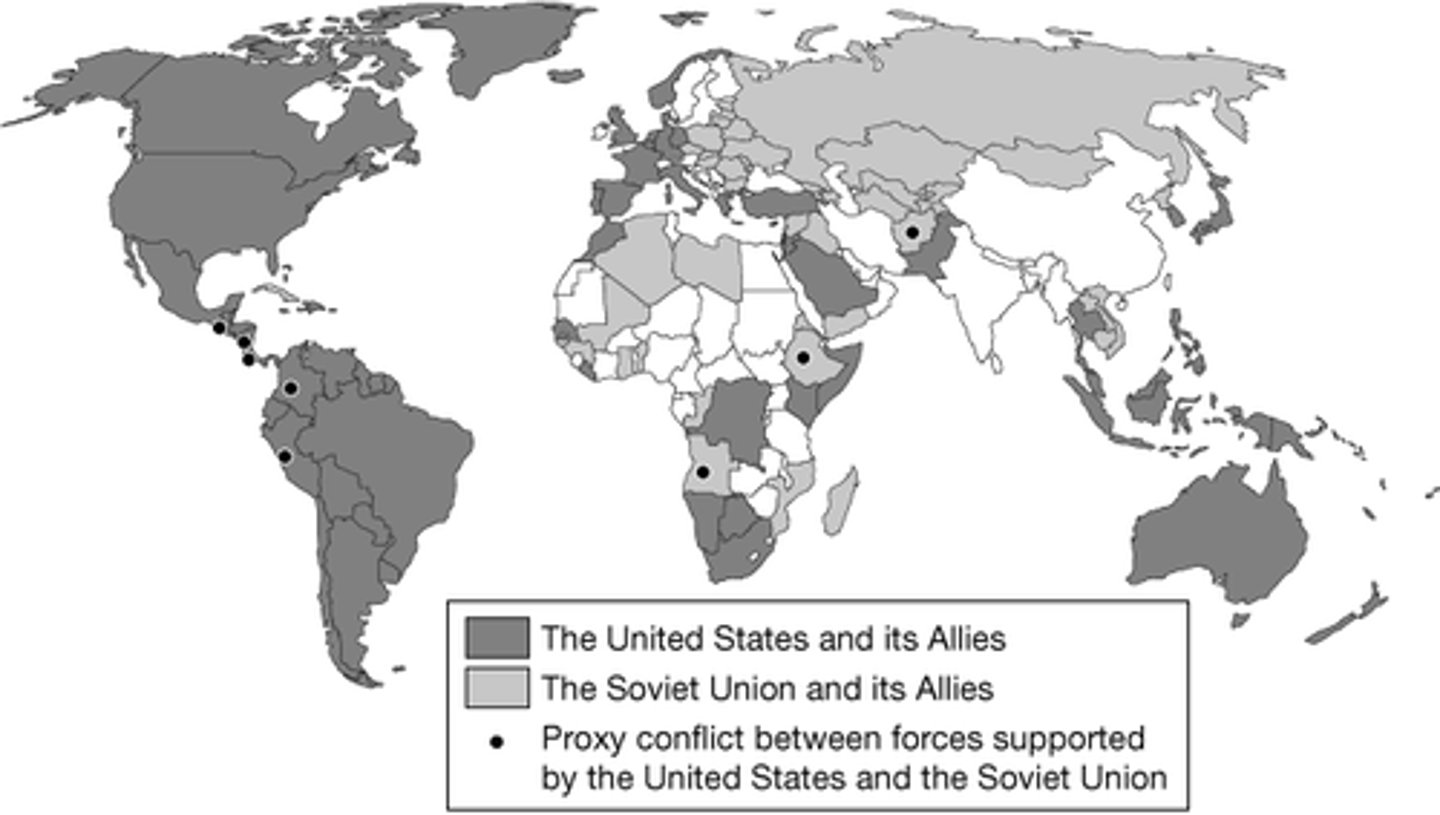
Which of the following best explains why the United States and the Soviet Union preferred to engage in the type of conflicts shown on the map?
A
To maintain control over their former colonial states through puppet governments
B
To avoid direct military confrontations that could lead to nuclear war
C
To obtain new military technology before a direct confrontation
D
To acquire natural resources by forcing states to favor United States or Soviet companies
B
To avoid direct military confrontations that could lead to nuclear war

All of the following contributed to the end of the political order depicted on the map EXCEPT
A
the expansion of United States military spending
B
the unsuccessful Soviet military intervention in Afghanistan
C
continued economic weakness in the Soviet Union following Gorbachev’s reforms
D
armed rebellions in Eastern European states against Soviet rule
D
armed rebellions in Eastern European states against Soviet rule

Which of the following most likely expresses the poster’s main message regarding the one-child policy?
A
The policy would lead to political reform of the communist system.
B
The policy would lead to an improvement in women’s social status.
C
The policy would guarantee China’s future prosperity and progress.
D
The policy would encourage a return to Confucian values of filial piety.
C
The policy would guarantee China’s future prosperity and progress.
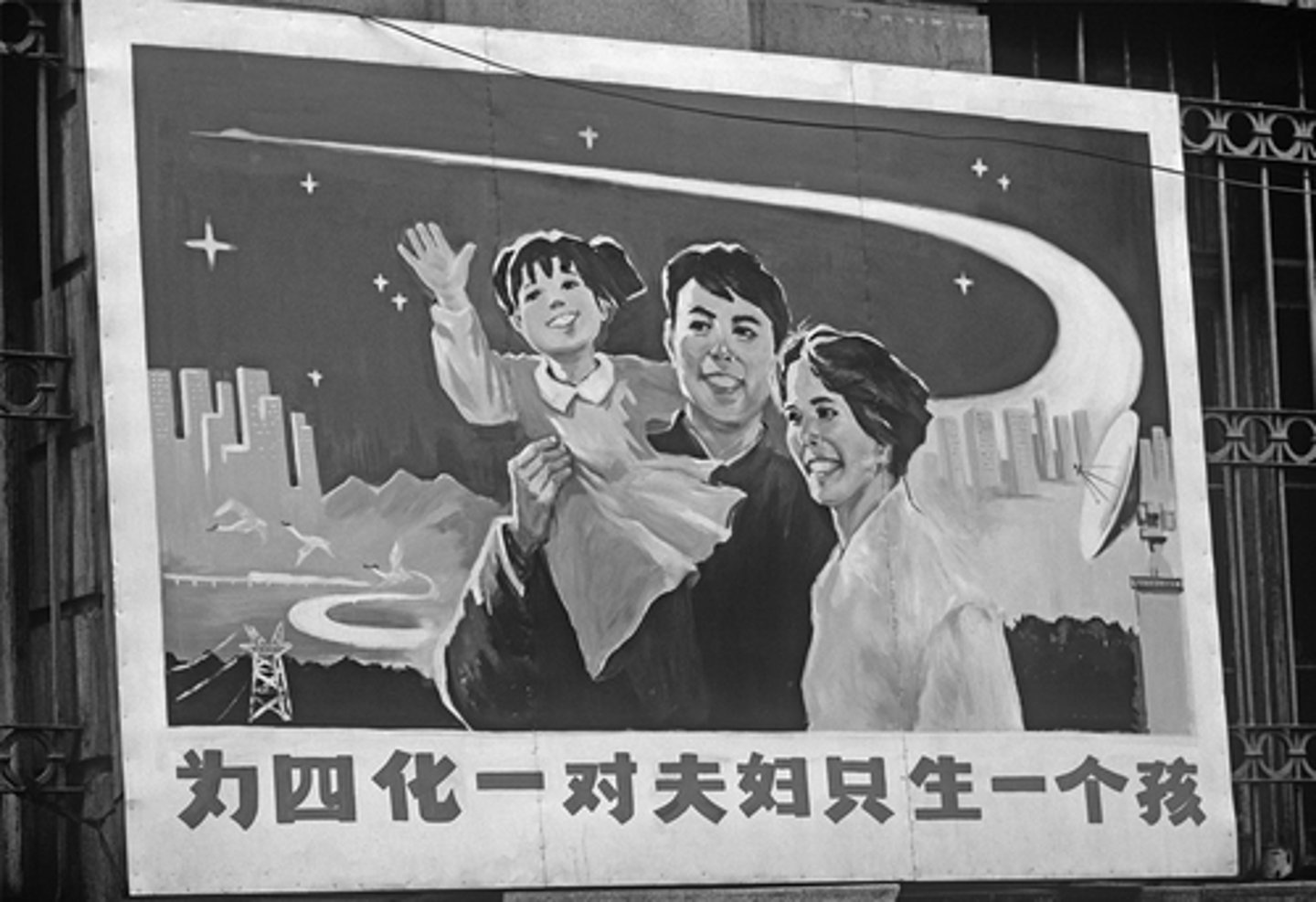
Which of the following features of communist China in the late twentieth century most likely enabled its government to carry out the policy shown in the image?
A
Its rapid urbanization
B
Its adoption of free-market reforms
C
Its widespread rural poverty
D
Its totalitarian system
D
Its totalitarian system
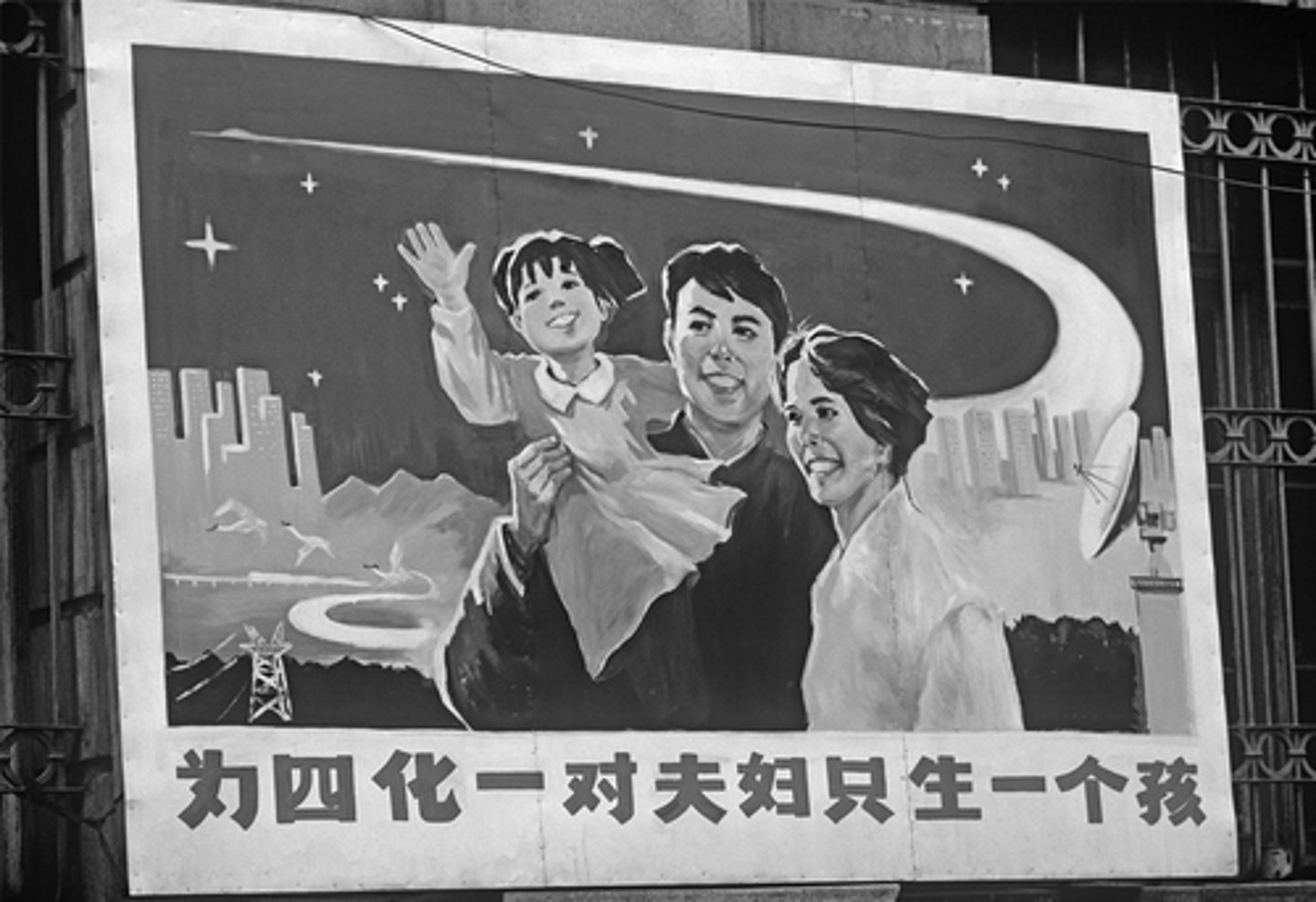
The poster could best be used to illustrate which of the following global trends in the post–Second World War period?
A
The increasing concern about possible negative social consequences of technological development
B
The tendency of governments to take a strong role in guiding their countries’ economic and social development
C
The rapid pace of cultural exchange enabled by improved forms of communication
D
The rejection of large-scale institutions by those favoring the devolution of power to the local level
B
The tendency of governments to take a strong role in guiding their countries’ economic and social development

"On May 21, 1987, exactly a week after the elected government of Fiji* had been ousted in a military coup . . . a huge bused-in crowd of ethnic Fijian men and women sat on the lawn across the Civil Center in the capital city, clapping and singing, while the Royal Fiji Military Forces band played 'Onward Christian Soldiers.' Across the park, another crowd of Indo-Fijian men and women and children watched apprehensive, bewildered, frightened. . . . The coup-maker, Lt. Col. Sitiveni Rabuka, an ethnic Fijian, appeared on the balcony. . . . With both fists punching the air, he addressed his supporters, ' [Ethnic] Fijians must rule Fiji: that is God's wish.'
Ten years later, Prime Minister Rabuka, now a mellowed, greyer, balding man, addressed a multiracial election rally: 'You cannot build a nation up by tearing each other down. That is why we focus on the need for us to be united—the indigenous Fijian people, [as well as] the sons and daughters and grandchildren of those who came as indentured laborers [from India], or in the following waves of business people are all inextricable parts of the new Republic of the Fiji Islands.'"
*the Fijian general elections of 1987 had brought to power a government dominated by political parties associated with Fiji's ethnic Indian community. Many ethnic Fijians resented the election results.
Brij Lal, Fijian historian of Indian ethnicity, article published in an academic journal, 2000
Which of the following nineteenth-century processes most directly contributed to the migration of Indian laborers to Fiji as described in the passage?
A
Indian merchants acted as brokers and middlemen for European East India companies.
B
Colonial states in Asia and the Pacific relied on coerced labor to work on plantations.
C
Prior to the abolition of the slave trade, Indian slaves were exported to the islands in the Pacific Ocean and the Indian Ocean.
D
Indo-Muslim traders spread Islam to the islands of Southeast Asia.
B
Colonial states in Asia and the Pacific relied on coerced labor to work on plantations.
“On May 21, 1987, exactly a week after the elected government of Fiji* had been ousted in a military coup . . . a huge bused-in crowd of ethnic Fijian men and women sat on the lawn across the Civil Center in the capital city, clapping and singing, while the Royal Fiji Military Forces band played ‘Onward Christian Soldiers.’ Across the park, another crowd of Indo-Fijian men and women and children watched apprehensive, bewildered, frightened. . . . The coup-maker, Lt. Col. Sitiveni Rabuka, an ethnic Fijian, appeared on the balcony. . . . With both fists punching the air, he addressed his supporters, ‘ [Ethnic] Fijians must rule Fiji: that is God’s wish.’
Ten years later, Prime Minister Rabuka, now a mellowed, greyer, balding man, addressed a multiracial election rally: ‘You cannot build a nation up by tearing each other down. That is why we focus on the need for us to be united—the indigenous Fijian people, [as well as] the sons and daughters and grandchildren of those who came as indentured laborers [from India], or in the following waves of business people are all inextricable parts of the new Republic of the Fiji Islands.’”
*the Fijian general elections of 1987 had brought to power a government dominated by political parties associated with Fiji’s ethnic Indian community. Many ethnic Fijians resented the election results.
Brij Lal, Fijian historian of Indian ethnicity, article published in an academic journal, 2000
Which of the following processes most directly contributed to the tensions in Fiji described in the first paragraph?
A
Migrant groups often created relatively isolated ethnic enclaves, while receiving societies responded to them through ethnic prejudice.
B
Violence between cultural groups led to acts of genocide perpetrated by authoritarian military governments.
C
European colonial settlers destroyed indigenous populations and their cultures, replacing them with migrant groups.
D
Indigenous and migrant elites cooperated to overthrow European colonialism and secure independence.
A
Migrant groups often created relatively isolated ethnic enclaves, while receiving societies responded to them through ethnic prejudice.
"On May 21, 1987, exactly a week after the elected government of Fiji* had been ousted in a military coup . . . a huge bused-in crowd of ethnic Fijian men and women sat on the lawn across the Civil Center in the capital city, clapping and singing, while the Royal Fiji Military Forces band played 'Onward Christian Soldiers.' Across the park, another crowd of Indo-Fijian men and women and children watched apprehensive, bewildered, frightened. . . . The coup-maker, Lt. Col. Sitiveni Rabuka, an ethnic Fijian, appeared on the balcony. . . . With both fists punching the air, he addressed his supporters, ' [Ethnic] Fijians must rule Fiji: that is God's wish.'
Ten years later, Prime Minister Rabuka, now a mellowed, greyer, balding man, addressed a multiracial election rally: 'You cannot build a nation up by tearing each other down. That is why we focus on the need for us to be united—the indigenous Fijian people, [as well as] the sons and daughters and grandchildren of those who came as indentured laborers [from India], or in the following waves of business people are all inextricable parts of the new Republic of the Fiji Islands.'"
*the Fijian general elections of 1987 had brought to power a government dominated by political parties associated with Fiji's ethnic Indian community. Many ethnic Fijians resented the election results.
Brij Lal, Fijian historian of Indian ethnicity, article published in an academic journal, 2000
As outlined in the second paragraph, the changes in Rabuka's political rhetoric between 1987 and 1997 were most likely a result of which of the following?
A
The proliferation of ethnic and religious conflicts following the collapse of communism
B
The spread of democratization and economic globalization in the modern world
C
The discrediting of Social Darwinism and other racial "scientific" theories
D
The outsourcing of Western industrial production to developing economies in the Asia-Pacific region
B
The spread of democratization and economic globalization in the modern world